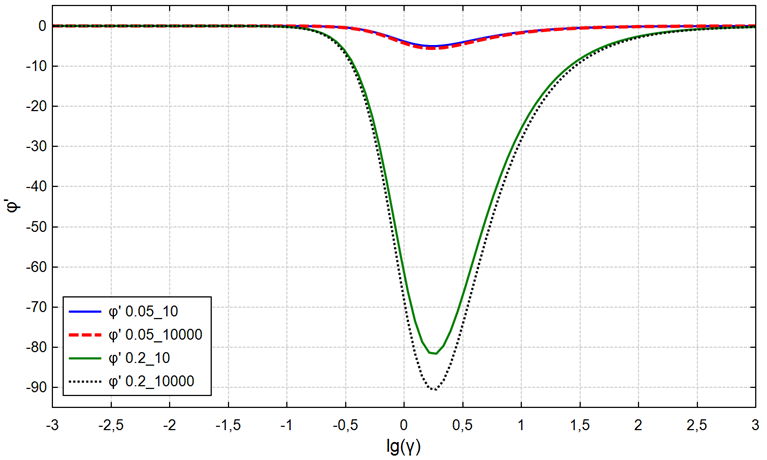Ultimate effect of non-identity of capacitive elements of high-voltage arm on frequency characteristics of voltage divider (analytical research)
DOI:
https://doi.org/10.20998/2074-272X.2021.4.06Keywords:
voltage divider, frequency characteristics, analytical expressions, tolerance of capacitive elements, parameters adjustmentAbstract
Purpose. Determination in the analytical form of the maximum limiting influence of the non-identity of the capacitive elements of the high-voltage arm on the amplitude-frequency characteristic and phase-frequency characteristic of the voltage divider with parallel-series connection of R-, C-elements of the high-voltage arm. Methodology. Based on the previously developed theory of broadband voltage dividers with parallel-series connection of R-, C-elements, analytical expressions for amplitude-frequency and phase-frequency characteristics of the voltage divider are obtained and investigated taking into account the limit case of non-identical capacitive elements of high-voltage arm. Results. The nature of the dependencies of the frequency characteristics of the broadband voltage divider on the value of the tolerance of the capacitive elements of the high-voltage arm, the division factor of the voltage divider in a wide range of frequency changes is determined. Simplified approximating expressions for the maximum values of frequency characteristics of the voltage divider are proposed and their error is determined. Originality. For the first time in the analytical form the limiting influence of non-identity of capacitive elements of a high-voltage arm of a voltage divider on its frequency characteristics is considered. A mathematical model of this influence is constructed and the limit values of frequency characteristics of the voltage divider are determined. Practical value. It is recommended to introduce into the normative documentation of broadband voltage dividers the corrected value of the division factor, which allows to significantly reduce the deviation of the actual value of the division factor of the voltage divider from the normalized value in a wide range of frequency changes.
References
Anokhin Y.L., Brzhezytskyi V.O., Haran Ya.O., Masliuchenko I.M., Protsenko O.P., Trotsenko Ye.O. Application of high voltage dividers for power quality indices measurement. Electrical Engineering & Electromechanics, 2017, no. 6, pp. 53-59. doi: https://doi.org/10.20998/2074-272x.2017.6.08.
Li D., Liu K., Lei M., Zhou F., Yue C., Yu J. Study on the ratio change measurement of 1000 kV HVDC divider based on improved DC voltage summation method. High Voltage, 2020, vol. 5, no. 2, pp. 202-208. doi: https://doi.org/10.1049/hve.2019.0127.
Fang Z., Luo Y., Zhai S., Qian B., Liao Y., Lan L., Wang D. Temperature rise characteristics and error analysis of a DC voltage divider. Energies, 2021, vol. 14, no. 7, p. 1914. doi: https://doi.org/10.3390/en14071914.
Alf-Peter E., Hällström J., Bergman A. Optimization of the design of a wideband 1000 kV resistive reference divider. XVII International Symposium on High Voltage Engineering, Hannover, Germany, August 22-26, 2011. Available at: http://vlabs.iitkgp.ac.in/vhvlab/html/pages/CD/topics_a-h/H-013-ELG-F.pdf (accessed 22 June 2020).
Khamlichi A., Rovira J. The Design and characterization of a prototype wideband voltage sensor based on a resistive divider. Sensors, 2017, vol. 17, no. 11, p. 2657. doi: https://doi.org/10.3390/s17112657.
Slomovitz D., Trigo L., Faverio C., Kyriazis G.A. Advance in the development of wideband resistive voltage dividers. Journal of Physics: Conference Series, 2021, vol. 1826, no. 1, p. 012083. doi: https://doi.org/10.1088/1742-6596/1826/1/012083.
Hrbac R., Kolar V., Bartlomiejczyk M., Mlcak T., Orsag P., Vanc J. A development of a capacitive voltage divider for high voltage measurement as part of a combined current and voltage sensor. Elektronika ir Elektrotechnika, 2020, vol. 26, no. 4, pp. 25-31. doi: https://doi.org/10.5755/j01.eie.26.4.25888.
Xu D., Zhang W., Wang N., Wang G., Xu G. The power frequency voltage divider calibration device and its uncertainty. Energy Reports, 2020, vol. 6, pp. 380-384. doi: https://doi.org/10.1016/j.egyr.2019.11.091.
Havunen J., Hällström J. Reference switching impulse voltage measuring system based on correcting the voltage divider response with software. IEEE Transactions on Instrumentation and Measurement, 2021, vol. 70, pp. 1-8. art. no. 1006008. doi: https://doi.org/10.1109/tim.2021.3063753.
Brzhezitsky V., Trotsenko Y., Haran Y. Optimization of amplitude-frequency characteristic of broadband voltage divider intended for measurement of power quality parameters. Technology audit and production reserves, 2020, vol. 3, no. 1 (53), pp. 35-39. doi: https://doi.org/10.15587/2706-5448.2020.205132.
Brzhezitsky V., Haran Y., Derzhuk A., Trotsenko Y., Protsenko O. Amplitude-frequency characteristic of broadband voltage divider with ultimate adjustment of its low-voltage arm. 2020 IEEE 7th International Conference on Energy Smart Systems (ESS), 2020, pp. 111-115, doi: https://doi.org/10.1109/ess50319.2020.9160094.
Brzhezytskyi V.O., Masliuchenko I.M., Laposha M.Y. Maximum influence of nonidentical R- and C-elements of a high-voltage divider on its frequency characteristics. Power Engineering: economics, technique, ecology, 2017, no. 1, pp. 70-76. (Ukr). doi: https://doi.org/10.20535/1813-5420.1.2017.102824.
Korn G.A., Korn T.M. Mathematical handbook for Scientists and engineers. Dover Publications, 2000. 1151 p.

Downloads
Published
How to Cite
Issue
Section
License
Copyright (c) 2021 V. O. Brzhezitsky, Y. O. Haran, A. O. Derzhuk, O. R. Protsenko, Y. O. Trotsenko, M. M. Dixit

This work is licensed under a Creative Commons Attribution-NonCommercial 4.0 International License.
Authors who publish with this journal agree to the following terms:
1. Authors retain copyright and grant the journal right of first publication with the work simultaneously licensed under a Creative Commons Attribution License that allows others to share the work with an acknowledgement of the work's authorship and initial publication in this journal.
2. Authors are able to enter into separate, additional contractual arrangements for the non-exclusive distribution of the journal's published version of the work (e.g., post it to an institutional repository or publish it in a book), with an acknowledgement of its initial publication in this journal.
3. Authors are permitted and encouraged to post their work online (e.g., in institutional repositories or on their website) prior to and during the submission process, as it can lead to productive exchanges, as well as earlier and greater citation of published work.




